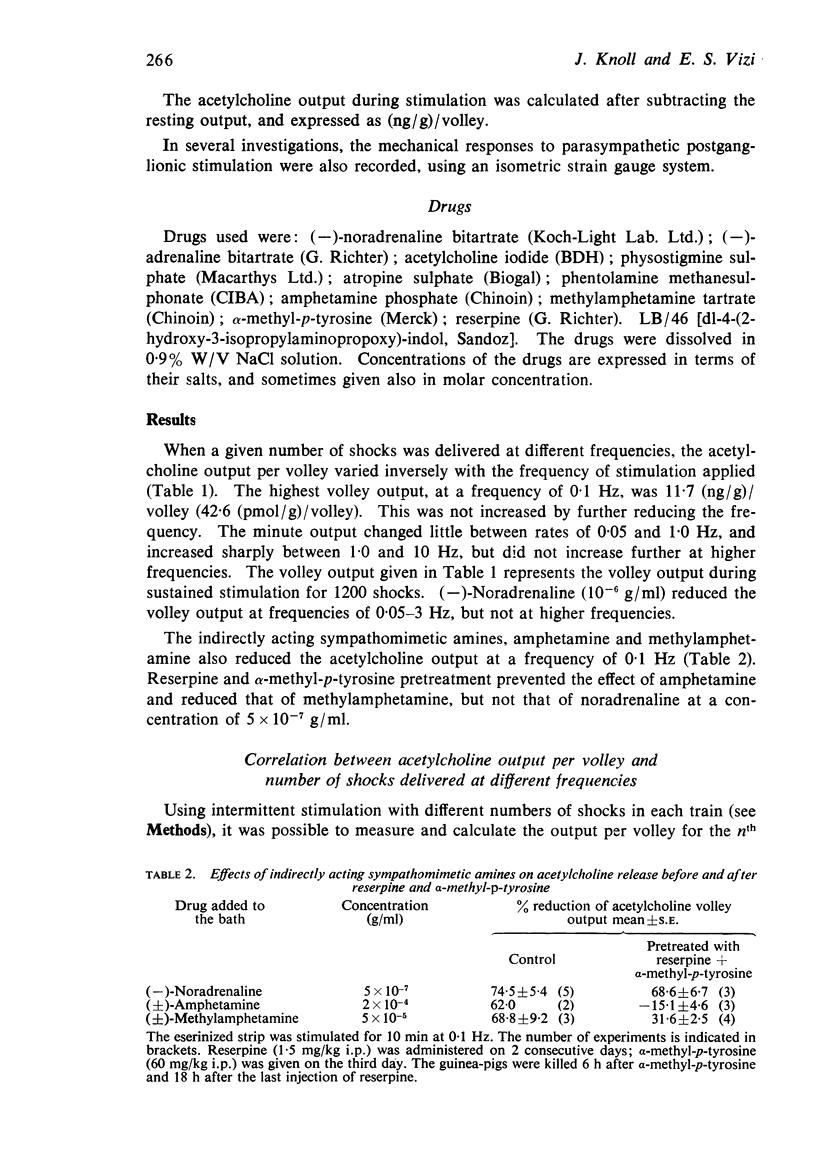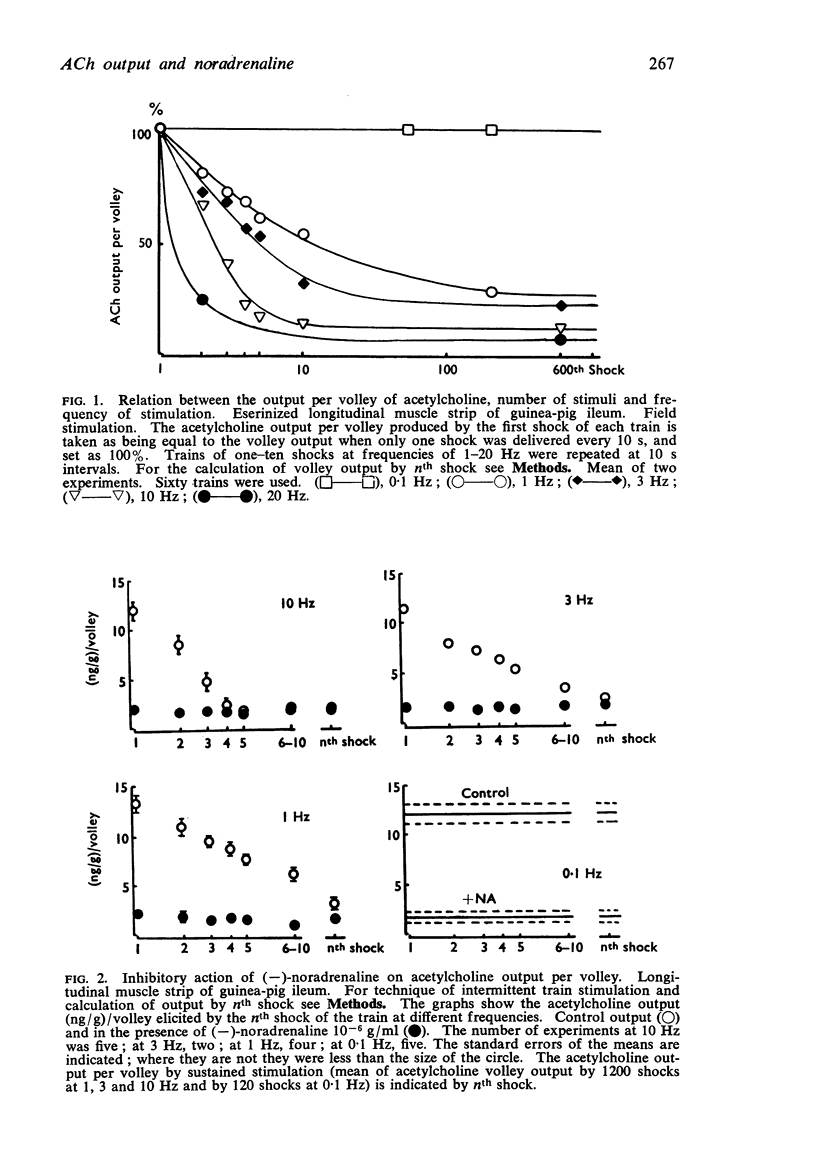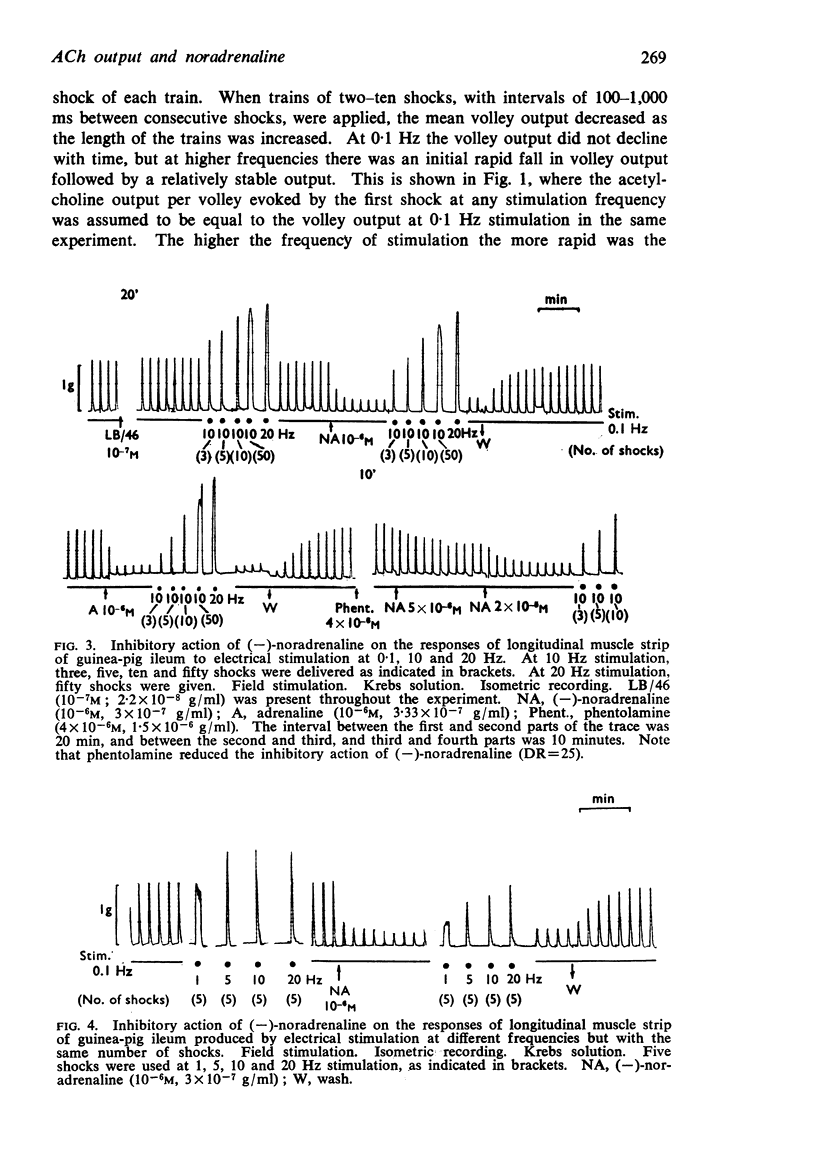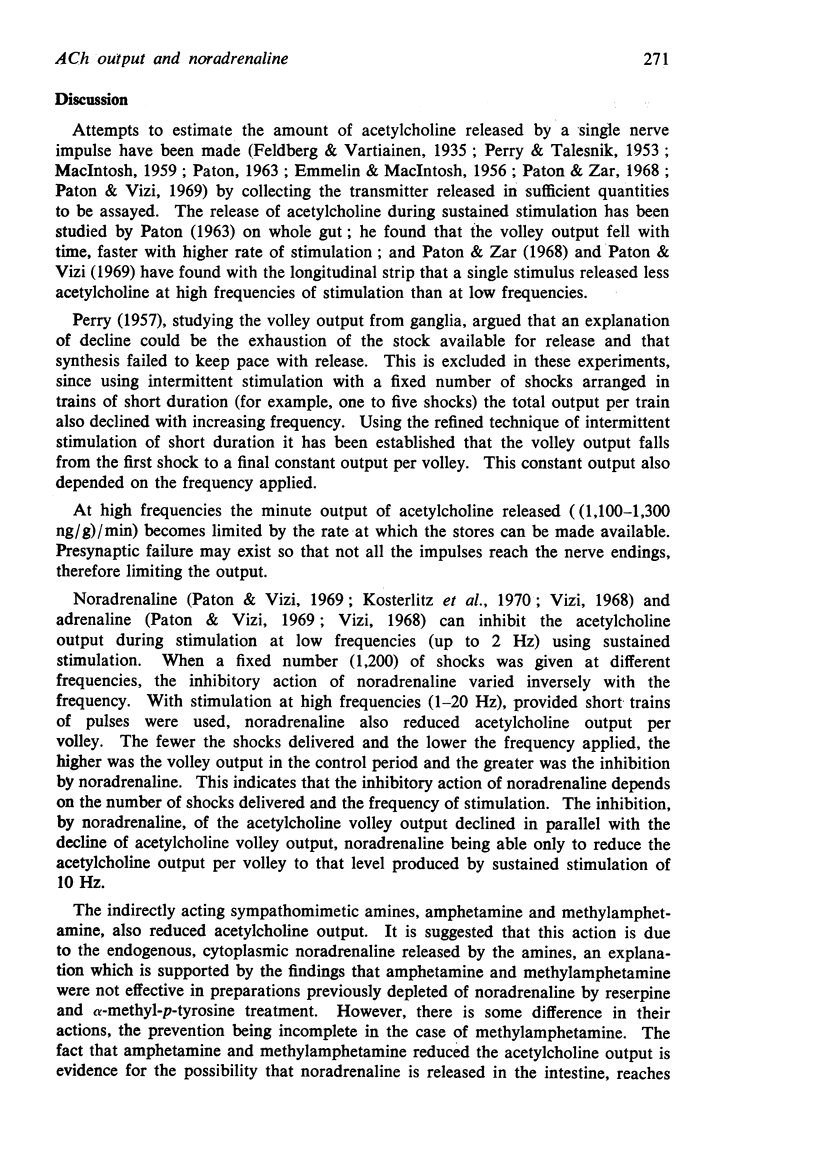Abstract
1. The relationship between the number of shocks delivered, the frequency of stimulation and the acetylcholine output per volley from nerve terminals of the longitudinal muscle strip of the guinea-pig ileum was studies.
2. There was an inverse correlation between acetylcholine output per volley and the frequency of stimulation when the same number of shocks was applied in each train.
3. With sustained stimulation, the volley output declined more rapidly the higher the frequency of stimulation. There was no decrease in volley output (11·7 (ng/g)/volley) when the frequency applied was 0·1 Hz or less.
4. Noradrenaline (10-6 g/ml) reduced the acetylcholine output per volley to the level produced by sustained stimulation at 10 Hz (1·4-1·9 (ng/g)/volley). The acetylcholine output following application of the first shocks of a train at high frequency stimulation was much reduced by noradrenaline as the output was higher than 1·4-1·9 (ng/g)/volley. This action of noradrenaline was antagonized by phentolamine (2 μg/ml for 20 min).
5. Amphetamine and methylamphetamine, which release NA from sympathetic nerve terminals, were active in reducing the acetylcholine output to low frequency parasympathetic nerve stimulation. Reserpine and α-methyl-p-tyrosine pretreatment prevented the effect of amphetamine and reduced that of methylamphetamine.
6. The fact that addition or release of noradrenaline, reduced acetylcholine output when the firing rate was high but short in duration, suggests that noradrenaline plays a general modulator role in controlling the output of acetylcholine from the parasympathetic nerve terminals.
Full text
PDF









Selected References
These references are in PubMed. This may not be the complete list of references from this article.
- Beani L., Bianchi C., Crema A. The effect of catecholamines and sympathetic stimulation on the release of acetylcholine from the guinea-pig colon. Br J Pharmacol. 1969 May;36(1):1–17. doi: 10.1111/j.1476-5381.1969.tb08298.x. [DOI] [PMC free article] [PubMed] [Google Scholar]
- Cowie A. L., Kosterlitz H. W., Lydon R. J., Waterfield A. A. The effects of morphine-like substances and their antagonists on transmission at the neuro-effector junction of the myenteric plexus-longitudinal muscle preparation of the guinea-pig ileum. Br J Pharmacol. 1970 Feb;38(2):465P–466P. [PMC free article] [PubMed] [Google Scholar]
- Cowie A. L., Kosterlitz H. W., Watt A. J. Mode of action of morphine-like drugs on autonomic neuro-effectors. Nature. 1968 Dec 7;220(5171):1040–1042. doi: 10.1038/2201040a0. [DOI] [PubMed] [Google Scholar]
- EMMELIN N., MACINTOSH F. C. The release of acetylcholine from perfused sympathetic ganglia and skeletal muscles. J Physiol. 1956 Feb 28;131(2):477–496. doi: 10.1113/jphysiol.1956.sp005477. [DOI] [PMC free article] [PubMed] [Google Scholar]
- Feldberg W., Vartiainen A. Further observations on the physiology and pharmacology of a sympathetic ganglion. J Physiol. 1934 Dec 14;83(1):103–128. doi: 10.1113/jphysiol.1934.sp003214. [DOI] [PMC free article] [PubMed] [Google Scholar]
- Kosterlitz H. W., Lydon R. J., Watt A. J. The effects of adrenaline, noradrenaline and isoprenaline on inhibitory alpha- and beta-adrenoceptors in the longitudinal muscle of the guinea-pig ileum. Br J Pharmacol. 1970 Jun;39(2):398–413. doi: 10.1111/j.1476-5381.1970.tb12903.x. [DOI] [PMC free article] [PubMed] [Google Scholar]
- MACINTOSH F. C. Formation, storage, and release of acetylcholine at nerve endings. Can J Biochem Physiol. 1959 Feb;37(2):343–356. [PubMed] [Google Scholar]
- PATON W. D. CHOLINERGIC TRANSMISSION AND ACETYLCHOLINE OUTPUT. Can J Biochem Physiol. 1963 Dec;41:2637–2653. [PubMed] [Google Scholar]
- PATON W. D. The action of morphine and related substances on contraction and on acetylcholine output of coaxially stimulated guinea-pig ileum. Br J Pharmacol Chemother. 1957 Mar;12(1):119–127. doi: 10.1111/j.1476-5381.1957.tb01373.x. [DOI] [PMC free article] [PubMed] [Google Scholar]
- PERRY W. L. M., TALESNIK J. The role of acetylcholine in synaptic transmission at parasympathetic ganglia. J Physiol. 1953 Mar;119(4):455–469. doi: 10.1113/jphysiol.1953.sp004859. [DOI] [PMC free article] [PubMed] [Google Scholar]
- PERRY W. L. Transmission in autonomic ganglia. Br Med Bull. 1957 Sep;13(3):220–226. doi: 10.1093/oxfordjournals.bmb.a069617. [DOI] [PubMed] [Google Scholar]
- Paton W. D., Vizi E. S. The inhibitory action of noradrenaline and adrenaline on acetylcholine output by guinea-pig ileum longitudinal muscle strip. Br J Pharmacol. 1969 Jan;35(1):10–28. doi: 10.1111/j.1476-5381.1969.tb07964.x. [DOI] [PMC free article] [PubMed] [Google Scholar]
- Paton W. D., Zar M. A. The origin of acetylcholine released from guinea-pig intestine and longitudinal muscle strips. J Physiol. 1968 Jan;194(1):13–33. doi: 10.1113/jphysiol.1968.sp008392. [DOI] [PMC free article] [PubMed] [Google Scholar]
- RANG H. P. STIMULANT ACTIONS OF VOLATILE ANAESTHETICS ON SMOOTH MUSCLE. Br J Pharmacol Chemother. 1964 Apr;22:356–365. doi: 10.1111/j.1476-5381.1964.tb02040.x. [DOI] [PMC free article] [PubMed] [Google Scholar]
- Vizi E. S. The inhibitory action of noradrenaline and adrenaline on release of acetylcholine from guinea-pig ileum longitudinal strips. Naunyn Schmiedebergs Arch Exp Pathol Pharmakol. 1968;259(2):199–200. doi: 10.1007/BF00537789. [DOI] [PubMed] [Google Scholar]


